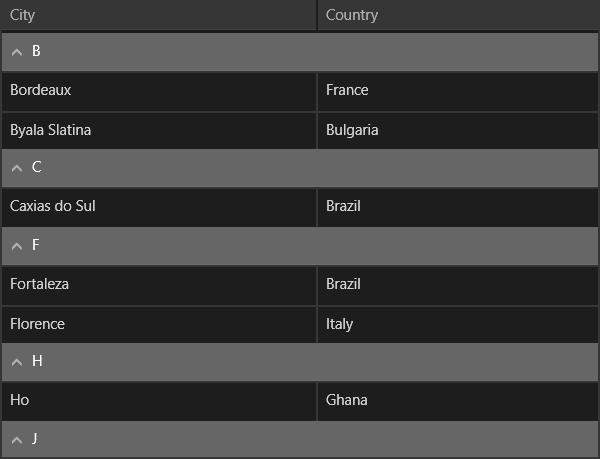DelegateGroupDescriptor
In this article we are going to present the DelegateGroupDescriptor and show how to use it.
The difference between the DelegateGroupDescriptor and the PropertyGroupDescriptor is that DelegateGroupDescriptor groups data by a custom Key while the PropertyGroupDescriptor groups by a defined Key which is a property from our model.
You have to set the following property of the DelegateGroupDescriptor:
- KeyLookup: Gets or sets the IKeyLookup instance that is used to retrieve the group key for each data item.
You can easily sort the groups in ascending or descending order using the SortOrder property.
You have to create a class that implements the IKeyLookup interface which will return the Key you want to group by. Then you need to add the DelegateGroupDescriptor to the RadDataGrid.GroupDescriptors collection and set its KeyLookUp property.
Example
Let's see how this actually works. In the following example we have a data grid with cities and countries and we will group the grid items by the first letter of cities.

First, create a custom class that implements the IKeyLookup interface where the context we receive is our object:
public class CustomIKeyLookup : IKeyLookup
{
public object GetKey(object instance)
{
return (instance as DataClass).City[0];
}
}
And set the KeyLookup property to this class:
<grid:RadDataGrid Width="600" Height="460" x:Name="grid">
<grid:RadDataGrid.GroupDescriptors>
<telerikCore:DelegateGroupDescriptor>
<telerikCore:DelegateGroupDescriptor.KeyLookup>
<local:CustomIKeyLookup/>
</telerikCore:DelegateGroupDescriptor.KeyLookup>
</telerikCore:DelegateGroupDescriptor>
</grid:RadDataGrid.GroupDescriptors>
</grid:RadDataGrid>
where telerikCore namespace is:
xmlns:telerikCore="using:Telerik.Data.Core"
As you can see, in this case the key we return is the first letter from each City.
Next, create sample data and set it to the DataContext of our DataGrid:
List<DataClass> data = new List<DataClass>
{
new DataClass { Country = "Brazil", City = "Caxias do Sul"},
new DataClass { Country = "Ghana", City = "Wa"},
new DataClass { Country = "Brazil", City = "Fortaleza"},
new DataClass { Country = "Italy", City = "Florence" },
new DataClass { Country = "France", City = "Bordeaux" },
new DataClass { Country = "Bulgaria", City = "Vratsa"},
new DataClass { Country = "Spain", City = "Las Palmas"},
new DataClass { Country = "France", City = "Le Mans" },
new DataClass { Country = "Brazil", City = "Santos"},
new DataClass { Country = "Ghana", City = "Ho"},
new DataClass { Country = "Spain", City = "Malaga"},
new DataClass { Country = "France", City = "Marseille" },
new DataClass { Country = "Bulgaria", City = "Koynare" },
new DataClass { Country = "Spain", City = "Valencia"},
new DataClass { Country = "Ghana", City = "Kade" },
new DataClass { Country = "Brazil", City = "Porto Alegre" },
new DataClass { Country = "Bulgaria", City = "Byala Slatina"},
new DataClass { Country = "Italy", City = "Naples" },
new DataClass { Country = "Brazil", City = "Joinville" },
};
this.grid.ItemsSource = data;
DataClass is a custom class defining our objects:
public class DataClass
{
public string City { get; set; }
public string Country { get; set; }
}